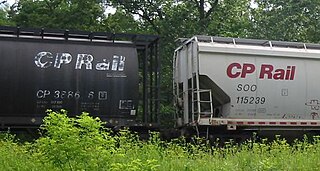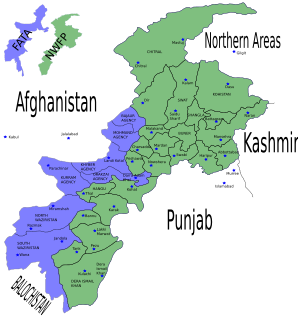
The North-West Frontier region of the British Indian Empire was a difficult area to conquer in South Asia, strategically and militarily. It remains the western frontier of present-day Pakistan, extending from the Pamir Knot in the north to the Koh-i-Malik Siah in the west, and separating the modern Pakistani frontier regions of North-West Frontier Province, Federally Administered Tribal Areas and Balochistan from neighbouring Afghanistan in the west. The borderline between is officially known as the Durand Line and divides Pashtun inhabitants of these provinces from Pashtuns in eastern Afghanistan.

The Ministry of Railways is a ministry of the Government of Pakistan tasked with planning, administrating and overseeing government policies for the development of the national rail network, Pakistan Railways. Originally a department of the Ministry of Communications, in May 1974 it formed into an autonomous ministry of the federal government. The ministry headquarters is located at Block D of the Pak Secretariat in Islamabad.
Rail transport in Pakistan began in 1855 during the British Raj, when several railway companies began laying track and operating in present-day Pakistan. The country's rail system has been nationalised as Pakistan Railways. The system was originally a patchwork of local rail lines operated by small private companies, including the Scinde, Punjab and Delhi Railways and the Indus Steam Flotilla. In 1870, the four companies were amalgamated as the Scinde, Punjab & Delhi Railway. Several other rail lines were built shortly thereafter, including the Sind–Sagar and Trans–Baluchistan Railways and the Sind–Pishin, Indus Valley, Punjab Northern and Kandahar State Railways. These six companies and the Scinde, Punjab & Delhi Railway merged to form the North Western State Railway in 1880. Following independence in 1947, the North Western Railway became Pakistan Western Railway and the rail system was reorganised; some of the reorganisation was controversial. Rail use increased in early 1948, and the network became profitable. Declining passenger numbers and financial losses in the late 1980s and early 1990s prompted the closure of many branch lines and small stations. The 1990s saw corporate mismanagement and severe cuts in rail subsidies. Due to falling passenger numbers, government subsidies are necessary to keep the railways financially viable.
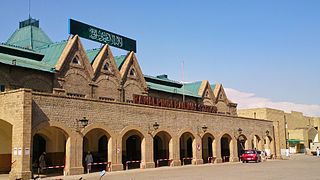
Rawalpindi railway station is located in Saddar area of Rawalpindi, Punjab, Pakistan. It is one of several major stops on the Karachi–Peshawar Railway Line. The nearest Saddar Metrobus Station, part of the Rawalpindi-Islamabad Metrobus is 20 minutes walk away.
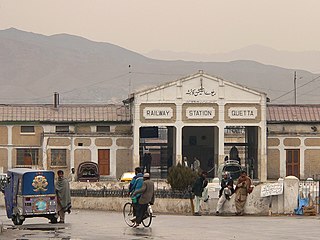
Quetta railway station is the main railway station of Quetta, Balochistan, Pakistan and serves as a major station on the Rohri-Chaman Railway Line and the eastern terminus of the Quetta-Taftan Railway Line.
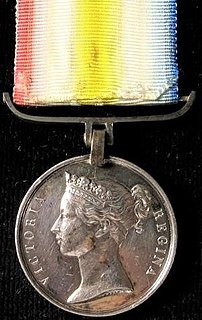
The Scinde Medal was authorised on 22 September 1843 and issued to soldiers of the Honourable East India Company, the 22nd Regiment of Foot of the British Army and members of the Indian Navy who manned the Indus Flotilla, who participated in Major General Sir Charles Napier's conquest of Scinde between 1842 and 1843.
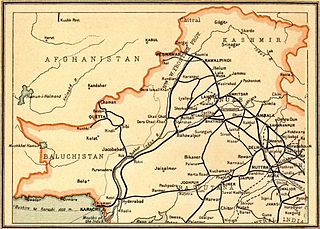
The North Western State Railway (NWR) was formed in January 1886 from the merger of the Scinde, Punjab & Delhi Railway, the Indus Valley State Railway, the Punjab Northern State Railway, the eastern section of the Sind–Sagar Railway and the southern section of the Sind–Pishin State Railway and the Kandahar State Railway.
The Ambala–Attari line is a railway line connecting Ambala Cantonment in the Indian state of Haryana and Attari in Punjab. The line is under the administrative jurisdiction of Northern Railway.
The Jalandhar–Jammu line is a railway line connecting Jalandhar Cantonment and Jalandhar City in the Indian state of Punjab with Jammu Tawi in Jammu & Kashmir. The line is under the administrative jurisdiction of Northern Railway.
The Amritsar–Pathankot line is a railway line connecting Amritsar and Pathankot Junction both in the Indian state of Punjab. The line is under the administrative jurisdiction of Northern Railway.
The Ludhiana–Fazilka line is a railway line connecting Ludhiana and Fazilka both in the Indian state of the Punjab. The line is under the administrative jurisdiction of Northern Railway.
Karachi–Peshawar Railway Line is one of four main railway lines in Pakistan, operated and maintained by Pakistan Railways. The line begins from Karachi City station or Kiamari station and ends at Peshawar Cantonment Station. The total length of this railway line is 1,687 kilometers (1,048 mi). There are 184 railway stations from Kiamari to Peshawar Cantonment on this line. The line serves as the main passenger and freight line of the country. 75% of the country's cargo and passenger traffic uses the line. The line is currently undergoing a six-year ₨886.68 billion (US$6.3 billion) upgrade and renovation as part of the China Pakistan Economic Corridor, with average rail speeds expected be doubled to 160 kilometers per hour upon completion.
The Scinde, Punjab, Delhi Railway was formed in 1870 from the incorporation of the Scinde Railway, Indus Steam Flotilla, Punjab Railway and Delhi Railway companies. This was covered by the Scinde Railway Company's Amalgamation Act of 1869.
The Indus Valley State Railway was a railway founded in 1871 to provide a rail link between Kotri and Multan and to replace the Indus Steam Flotilla. The opening of the line thus connected Karachi with Lahore.
The Punjab Northern State Railway, opened in 1876, was a railway line between Lahore and Peshawar.
The Sind–Sagar Railway was originally constructed as a Metre Gauge railway line from Lala Musa to Malakwal. In 1886 the Sind–Sagar Railway was amalgamated with other railways to form the North Western State Railway and railway line from was converted to broad gauge. The Chak Nizam Bridge, also known as Victoria Bridge, was completed in early 1887 over the Jhelum river in Shahpur District and connected Jhelum to Lahore. The NWR Sind-Sagar Branch Line was the new name for the line and continued to be extended with branch lines and designated as part of the 'Frontier Section - Military Line'.
The Kandahar State Railway opened c.1881, originally ran from Sibi and then on wards to Rindli, with the intention to reaching Quetta and onwards to Kandahar. However, the line never reached Quetta. The Kandahar State Railway joined with the southern section of the Sind–Pishin State Railway and in 1886 amalgamated, with other railways, to form North Western State Railway (NWR).
